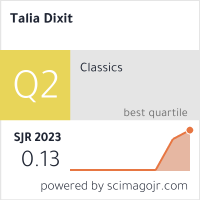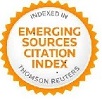Arengas, retórica e historiografía: Reflexiones sobre la Rhetorica militaris de Siriano Magister
Palabras clave:
Siriano, Arenga, Retórica, Historiografía, Antigüedad grecolatina, BizancioResumen
La primera parte del presente estudio analiza el libro publicado recientemente por Immacolata Eramo sobre los Discursos de Guerra (Bari 2010) del rétor bizantino Siriano Magister. Esta obra ofrece una cuidada edición, la primera traducción realizada del texto en su totalidad y un detallado comentario. En la segunda, a partir de esta publicación, ofrecemos también una reflexión sobre la relación entre discurso exhortativo y normativa retórica desde la Antigüedad hasta Bizancio con el objetivo de poner de manifiesto la importancia de este tratado de época bizantina, cuyo auténtico valor sólo puede apreciarse si se tiene en cuenta la tradición historiográfica y retórica grecolatinas en las que se inserta la arenga militar
Descargas
Referencias
AHRWEILER,H.(1967),“Un discours inédit de Constantin VII Porphyrogénète”, Travaux et Mémoires 2, 393-404.
ALBERTUS,J.(1908),Die paraklêtikoí in der griechischen und römischen Literatur, Estrasburgo.
CARMONA CENTENO, D. (2008), La epipólesis en la historiografía griega y romana, tesís doctoral, Cáceres: Universidad de Extremadura.
DAIN, A. (1953), “Le encyclopédisme de Constantin Porphyrogénète“, Bulletin de l'Association Guillaume Budé 4, 64-81.
____ (1954), “La transmision des textes littéraires classiques de Photius à Constantin Porphyrogénète”, Dumbarton Oaks Papers 8, 31-47.
ERAMO, I. (2007), “῏Ω ἄνδρες στρατιῶται. Demegorie protrettiche nell’AmbrosianusB 119 sup.”, Annali della Facoltà di Lettere e Filosofia dell’Università degli Studi di Bari50, 127-165.
____ (2010), “Retorica militare fra tradizione protrettica e pensiero strategico”, Talia dixit 5, 25-44.
HANSEN,M.H. (1993), “The Battle Exhortation in Ancient Historiography. Fact or Fiction?”, Historia 42, 161-180.
HORNBLOWER, S. (2008), A Commentary on Thucydides. Vol. III, Oxford: University Press.
IGLESIAS-ZOIDO,J.C.(2003), “La arenga militar en Jenofonte: a propósito de Ciropedia 3.3.48-55”, Norba 16, 157-166.
____ (2007), “The Battle Exhortation in Ancient Rhetoric”, Rhetorica 25, 145-165.
____ (2007a) “Historiografía e instrucción retórica: el ejemplo de la arenga militar”, en J. A. Fernández, F. Pordomingo y A. Stramaglia (eds.), School and Literature in Ancient Greece, Montecassino: Università di Montecassino, pp. 107-120.
____ (2010), “Una figura olvidada: el rétor Lesbonacte”, en Actas del XII Congreso Español de Estudios Clásicos. Valencia, Octubre de 2008, vol. II, Madrid: SEEC, pp. 381-388.
____ (2010a), “Aproximación a las claves de la más reciente investigación sobre la arenga militar (2008-2010)”, Talia dixit 5, 91-110.
____ (2011), El legado de Tucídides en la cultura occidental: discursos e historia, Coimbra: CECH.
IGLESIAS-ZOIDO, J.C. (ed.) (2008), Retórica e historiografía: el discurso militar en la
historiografía desde la Antigüedad hasta el Renacimiento, Madrid: Ediciones Clásicas.
KEITEL, E. (1987), “Homeric Antecedents to the Cohortatio in the Ancient Historians”, Classical World 80, 153-172.
MCGEER, E. (2003), “Two military Orations of Constantine VII”, en N. Oikonomides (ed.), Byzantine Authors: Texts and Translations dedicated to the Memory of N. Oikonomides, Leiden: Brill, pp. 111-135.
MOSSE, C. (1963), “Armée et cité grecque (à propos de Thucydide VII.77.4-5)”, Revue des Études Anciennes 65, 290-297.
NICOLAI, R. (1992), La storiografia nell'educazione antica, Pisa: Giardini.
____ (2001), “Il generale, lo storico e i barbari: a proposito del discorso di Brasida in Thuc. IV 126”, in G. Arrighetti (ed.), Letteratura e riflessione sulla letteratura nella cultura classica. Atti del Convegno Pisa, 7-9 giugno 1999, Pisa, pp. 145-155.
PRITCHETT,W.K.(1994),“The General’s Exhortations in Greek Warfare”, en Essays in Greek History, Amsterdam: Giessen, pp. 27-109.
____ (2002),Ancient Greek Battle Speeches and a Palfrey, Amsterdam: Giessen.
RANCE, Ph. (2007), “The Date of the Military Compendium of Syrianus Magister (Formerly the Sixth-Century Anonymus Byzantinus)”, Byzantinische Zeitschrift 100, 701-737.
ROMILLY, J. de (1956), Histoire et raison chez Thucydide, París: Belles Lettres.
SCHMID, W. T. (1992), On manly courage: a study of Plato's Laches, Southern Illinois: University Press.
TARAGNA, A.M. (2000), Logoi historias. Discorsi e lettere nella prima storiografia retorica bizantina, Alessandria: Edizioni dell’Orso.
____ (2004), “Logos e polemos: eloquenza e persuasione nei trattati bizantini di arte militare”, Siculorum Gymnasium 57, 797-810.
TATUM, J. (1989), Xenophon’s Imperial Fiction (On the Education of Cyrus), Princeton: University Press.
VARI, R. (1908), “Zum historischen Excerptenwerke des Konstantinos Porphyrogenetos”, Byzantinische Zeitschrift 17, 75-85.
ZUCKERMAN, C. (1990), “The Military Compendium of Syrianus Magister”, Jahrbuch der Österreichischen Byzantinistik 40, 209-224.












